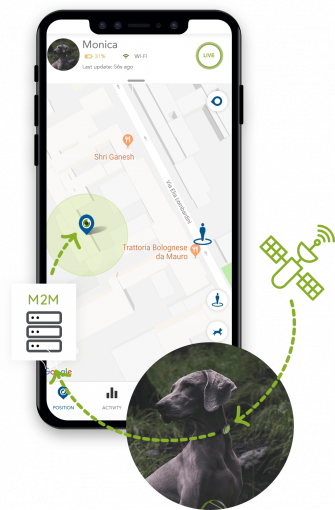When choosing a pet tracker, one of the first characteristics to be taken into account is the GPS accuracy, in other words, the reliability of the system that makes geolocation possible. The more accurate the information that the device sends to the smartphone or tablet, the more we will be sure we will never lose sight of our four-legged friend. To better understand the parameters to be taken into consideration, it may be appropriate to learn more about the technologies that make geolocation possible.
First of all, one of the best known and most used positioning systems, even outside the world of pet trackers, is the American one, called NAVSTAR in full, which stands for Navigation System with Timing And Ranging Global Positioning System, and known by most as GPS. Thanks to a network of satellites that are in orbit around the earth, this system informs us about the latitude and longitude of a specific thing, person or – in our case – pet, at any time.
How does Kippy evo tracker work?

Let’s take a more specific example: when we activate Kippy Evo, the tracker identifies the position of the satellites, then – through the triangulation of the information received – establishes its position and communicates it to the associated device, showing it on the map through a Radius, that is a circle that progressively narrows, circumscribing up to an accuracy of 2.5 m with GPS and 4 m with GLONASS.
The American GPS system is certainly the best known, but it is not the only one. In fact, there are also the Russian GLONASS, the Chinese BeiDou and the European Galileo in its completion phase. Kippy Evo uses GPS and additionally the GLONASS system to further increase GPS accuracy. Furthermore, with this in mind, Kippy Evo uses a series of systems designed to always guarantee geolocation and in a timely manner.
In fact, the GPS signal tends to be less accurate when the object is stationary (a phenomenon known as “wondering”) and is affected by the presence of physical obstacles: in closed spaces, for example, it is often not possible to communicate with satellites.
Kippy Evo responds to both of these problems, in the first case by limiting “wondering” thanks to an advanced technological device; in the second, thanks to the use of Wi-Fi. With respect to signal timeliness, the tracker is able to reduce the “fixing”, that is to say the time required for a device to establish initial contact with the satellites immediately after switching on – through Assisted GPS or A- GPS.

Why is Kippy Evo better than other pet trackers?
Unlike mobile phones, which are always on and connected, pet trackers are often activated when needed. This means that when switched on, they must first obtain the list of satellites available at that moment: an operation that can take time and energy. Kippy Evo, on the other hand, remotely downloads the so-called ephemeris on a daily basis, that is to say, the planned satellite routes, to speed up the entire process and make the location timely and effective.
One last thing that makes Kippy Evo’s GPS accuracy among the best on the market is the use of a miniaturized module designed specifically for the world of wearables, designed and built by one of the most advanced companies in the sector: Swiss U-Blox.
